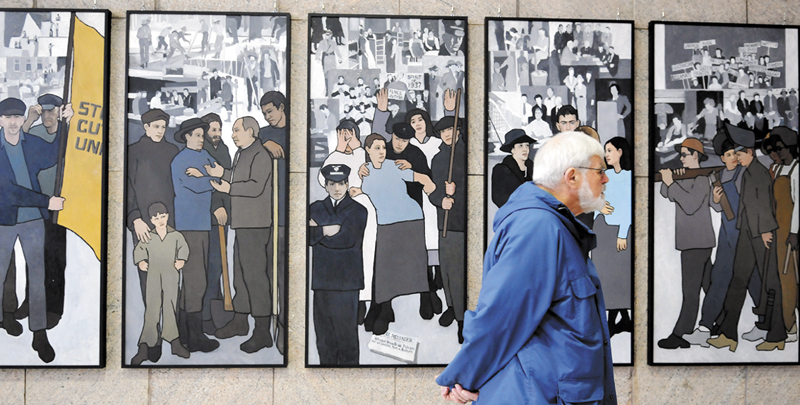One of the visitors who viewed the state’s infamous labor mural this week put it best.
“This is a much more visually appealing setting, I think,” said Richard Bamforth, of Augusta, when he visited the mural at its new home in the atrium of the Maine State Museum and Archives.
The mural, banished from the Department of Labor by Gov. Paul LePage nearly two years ago because it depicted labor movement history, was squirreled away in some secret place. It resurfaced this week in its much more public home.
It’s hard to say how many people in Augusta, or Maine for that matter, would know where the Department of Labor is. Hard to say how many would visit it even if they knew where to go. But the state museum — site of field trips, the state library, Mainers who need to take visiting relatives somewhere on a rainy day and anyone else wandering around the capital city — is a place of the people.
“I hope this will make people think about history, about the meaning of art and about art in public places,” museum director Bernard Fishman said in the same Associated Press article that quoted Bamforth.
Here’s hoping.
Most of us in Maine — and in America, for that matter — can trace our history back to ancestors who got kicked around. Maybe a little, maybe a lot, but kicked around nonetheless.
America had always prided itself on being on the side of the kickees, not the kickers.
One of our country’s most famous and beloved pieces of public art, as a matter of fact, is a monument to the kickees.
The Statue of Liberty welcomes the poor, the tired, the “huddled masses yearning to breathe free.” It doesn’t get more pro-kickee than that.
Now, to be honest, America takes more credit for being on the side of the kickees than it sometimes deserves.
Some of our ancestors came here from being kicked around somewhere else and decided to do some kicking themselves.
Some of our ancestors came here from being kicked around only to get kicked around worse.
Some of our ancestors were happily minding their own business in their own country, not being kicked around at all, and were brought over here against their will for some major kicking.
And some of our ancestors were happily minding their own business right here, until someone else’s ancestors came over and decided to administer some major kicking.
What does any of this have to do with the labor mural? I’m getting to that.
One thing all the kickees have in common, whether here or somewhere else, is that someone decided that to keep them kickees, they had to stay in the dark. No owning property or businesses. No worshipping the way they wanted, or who they wanted. And certainly no not worshipping. No speaking their own language. And biggest of all, no education.
The liberal arts are called the liberal arts for a reason. The ancient Greeks and Romans knew people needed an education beyond just skills training to be productive, engaged and enlightened citizens.
The people they wanted to keep down — slaves, women — didn’t get access to that knowledge. “Liber” is Latin for “free,” and the liberal arts started as education for free people, the ones who got to be in charge.
One of the things we tried to do right in this country was make sure everyone had access to an education. We didn’t always do it right, and our definition of “everyone” has hit some roadblocks over the past 236 years; but enough people have taken it seriously that there have always been Americans fighting to make sure the people in control get it right.
Part of that is having access to art. Not just field trips to museums, but living in a society that values art and recognizes its place in the public forum.
Societies are measured by their art, what they’ve left behind, what their attitude has been toward it. Think Renaissance vs. Dark Ages.
The past decade or so, though, we’ve hit a snag as far as the importance of art, and education in general, goes. Art is political. It’s liberal — the “bad” kind of liberal, not the “free” kind. It’s expensive; it’s for people who are snooty or rich or hoity-toity or pretentious.
A cynic would say that there are people in this country who promote that view to keep the rabble from thinking too much and making changes.
But those are the cynics, right? Because we may have our problems, but we’re not the kind of society that burns books or keeps knowledge from people.
Not the kind of society that would keep a mural depicting the history of labor — the worker’s history rather than the bosses’ history — under wraps because we don’t like what it depicts.
Certainly not the kind of society that wouldn’t trust its free and enlightened people to look at those 11 panels depicting the history of labor, complete with the millworkers and farmers who helped build our region, and draw their own conclusions.
No, we’re not that kind of society, and we’ve got proof.
The mural is in a public place. A people’s place where anyone who wants to — anyone — can walk in for free, look it over and think whatever thoughts about it that a free, engaged and enlightened citizen wants to think.
Maureen Milliken is news editor of the Kennebec Journal and Morning Sentinel. She grew up in Augusta. Kennebec Tales appears the first and third Thursday of the month. Email her at mmilliken@mainetoday.com.
Copy the Story LinkSend questions/comments to the editors.




Success. Please wait for the page to reload. If the page does not reload within 5 seconds, please refresh the page.
Enter your email and password to access comments.
Hi, to comment on stories you must . This profile is in addition to your subscription and website login.
Already have a commenting profile? .
Invalid username/password.
Please check your email to confirm and complete your registration.
Only subscribers are eligible to post comments. Please subscribe or login first for digital access. Here’s why.
Use the form below to reset your password. When you've submitted your account email, we will send an email with a reset code.